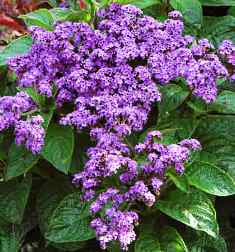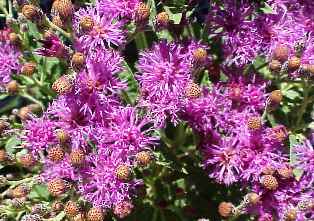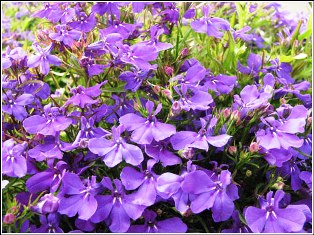Discover Florida Nature
It's time to explore the natural Florida


|
|
|
|
|
Browse through our alphabetical list of native Florida plants that
encourage butterflies into your garden, and find the perfect choices for
your Florida butterfly garden! Plants that have an asterisk beside their
name are especially high in nectar. Heliotrope
(Heliotropium spp )*- Heliotrope are Beautifully scented
clusters of violet blue flowers, which can grow to 6 inches wide.
Heliotrope has also been called “turnsole,” after its tendency to turn
its flowers and leaves toward the sun over the course of each day. And
at night it readjusts itself to face eastward, to be ready for sunrise.
That tendency is at the root of the name heliotrope, too. It means to
move with the sun. In fact, heliotrope wants plenty of sunlight, at
least through mid-day. The positioning it prefers is full sun in the
morning but some shelter in the late afternoon, lest its leaves burn.
Beyond that, it appreciates rich soil kept evenly moist. The heliotrope
is justly renowned for its cherry pie fragrance, which is all it's
cracked up to be. This native Floridian sub shrub has broad, course
leaves that look tropical, and a somewhat gnarly growth habit.
Heliotrope blooms in midsummer, and produces only one flower head per
stem. These in turn produce many smaller flowers continually, lasting
upwards of a couple months each. While not stunningly beautiful, they're
interesting to look at and smell nice for a long time, and the
butterflies love them. Heliotrope
(Heliotropium spp )*- Heliotrope are Beautifully scented
clusters of violet blue flowers, which can grow to 6 inches wide.
Heliotrope has also been called “turnsole,” after its tendency to turn
its flowers and leaves toward the sun over the course of each day. And
at night it readjusts itself to face eastward, to be ready for sunrise.
That tendency is at the root of the name heliotrope, too. It means to
move with the sun. In fact, heliotrope wants plenty of sunlight, at
least through mid-day. The positioning it prefers is full sun in the
morning but some shelter in the late afternoon, lest its leaves burn.
Beyond that, it appreciates rich soil kept evenly moist. The heliotrope
is justly renowned for its cherry pie fragrance, which is all it's
cracked up to be. This native Floridian sub shrub has broad, course
leaves that look tropical, and a somewhat gnarly growth habit.
Heliotrope blooms in midsummer, and produces only one flower head per
stem. These in turn produce many smaller flowers continually, lasting
upwards of a couple months each. While not stunningly beautiful, they're
interesting to look at and smell nice for a long time, and the
butterflies love them. Ironweed
(Vernonia angustifolia)- Often seen in meadows and fallow fields the
rich purple of the flowers and the tall straight stems make this plant
easy to spot through out the state of Florida. This native perennial
plant is 2-4 feet tall and unbranched. The central stem is round,
hairless, and white, light green, or reddish purple. The alternate
leaves are up to 5 inches long and ½ inch across. The ironweed flower
cluster is quite dense, rather than loose and spreading. The flowering
stalks may be slightly pubescent. A compound flower consists of 15-30
disk florets with a short cylinder of green bracts underneath. A disk
floret is magenta, with 5 spreading lobes and a prominent divided style.
The blooming period occurs from summer to early fall. There is no
noticeable floral scent, but butterflies definitely enjoy these flowers! Ironweed
(Vernonia angustifolia)- Often seen in meadows and fallow fields the
rich purple of the flowers and the tall straight stems make this plant
easy to spot through out the state of Florida. This native perennial
plant is 2-4 feet tall and unbranched. The central stem is round,
hairless, and white, light green, or reddish purple. The alternate
leaves are up to 5 inches long and ½ inch across. The ironweed flower
cluster is quite dense, rather than loose and spreading. The flowering
stalks may be slightly pubescent. A compound flower consists of 15-30
disk florets with a short cylinder of green bracts underneath. A disk
floret is magenta, with 5 spreading lobes and a prominent divided style.
The blooming period occurs from summer to early fall. There is no
noticeable floral scent, but butterflies definitely enjoy these flowers!  Lantana (Lantana
spp)*- Common lantana is a rugged evergreen shrub from the tropics. The
species will grow to 6 feet high and may spread to 8 feet in width with
some varieties able to clamber vine-like up supports to greater heights.
The leaves are 2-5 inches long by 1-2 inches wide with rounded tooth
edges and a textured surface. Stems and leaves are covered with rough
hairs and emit an unpleasant aroma when crushed. The small flowers are
held in clusters, called umbels that are typically 1-2 inches across. In
the tropics lantana is a non-stop bloomer. Where it is killed to the
ground by frost the lantana blooms in summer and fall. Flower color
ranges from white to yellow, orange to red, pink to rose in unlimited
combinations, in addition the flowers usually change in color as they
age. A lantana may look orange from a distance but the flowerhead is
examined at close range it consists of individual white, yellow and red
flowers that blend when viewed from afar. Lantana is a favorite species
for butterflies and non-invasive lantanas should be a part of any
butterfly garden. Lantana (Lantana
spp)*- Common lantana is a rugged evergreen shrub from the tropics. The
species will grow to 6 feet high and may spread to 8 feet in width with
some varieties able to clamber vine-like up supports to greater heights.
The leaves are 2-5 inches long by 1-2 inches wide with rounded tooth
edges and a textured surface. Stems and leaves are covered with rough
hairs and emit an unpleasant aroma when crushed. The small flowers are
held in clusters, called umbels that are typically 1-2 inches across. In
the tropics lantana is a non-stop bloomer. Where it is killed to the
ground by frost the lantana blooms in summer and fall. Flower color
ranges from white to yellow, orange to red, pink to rose in unlimited
combinations, in addition the flowers usually change in color as they
age. A lantana may look orange from a distance but the flowerhead is
examined at close range it consists of individual white, yellow and red
flowers that blend when viewed from afar. Lantana is a favorite species
for butterflies and non-invasive lantanas should be a part of any
butterfly garden.
 Lobelia
(Lobelia spp)- Lobelia is an attractive annual or sometimes
biennial herb that grows to a height of three feet. Its erect, hairy
stem is angular, branching at the top, usually green with a tinge of
violet. The pale green or yellowish leaves have a sharp taste and a
slightly irritating odor. The sparse flowers are pale violet-blue
outside and pale yellow inside. Lobelias are profuse summertime
bloomers. As a matter of fact, these cool weather flowers will bloom all
the way to frost. They are a popular, easy to grow annual flower native
to a wide range of North and South America, including Florida. There are
a couple hundred varieties of Lobelia. Only a few varieties are commonly
gown in the home garden. Some Lobelia plant varieties are compact, only
growing 3 to 5 inches tall. Color varieties include white, blue, purple,
pink, and crimson. Blue is the most popular. Try these plants as border
edging, along creek beds, or anywhere you want to attract butterflies.
Medicinally, Lobelia plants have been used as a treatment for asthma,
bronchitis, and coughs. Lobelia
(Lobelia spp)- Lobelia is an attractive annual or sometimes
biennial herb that grows to a height of three feet. Its erect, hairy
stem is angular, branching at the top, usually green with a tinge of
violet. The pale green or yellowish leaves have a sharp taste and a
slightly irritating odor. The sparse flowers are pale violet-blue
outside and pale yellow inside. Lobelias are profuse summertime
bloomers. As a matter of fact, these cool weather flowers will bloom all
the way to frost. They are a popular, easy to grow annual flower native
to a wide range of North and South America, including Florida. There are
a couple hundred varieties of Lobelia. Only a few varieties are commonly
gown in the home garden. Some Lobelia plant varieties are compact, only
growing 3 to 5 inches tall. Color varieties include white, blue, purple,
pink, and crimson. Blue is the most popular. Try these plants as border
edging, along creek beds, or anywhere you want to attract butterflies.
Medicinally, Lobelia plants have been used as a treatment for asthma,
bronchitis, and coughs. |
|
|
Advertise | Privacy Statement | Contact | Alaska Nature | Michael Arnold Art| Dog Encyclopedia | Dog Encyclopedia| |
|